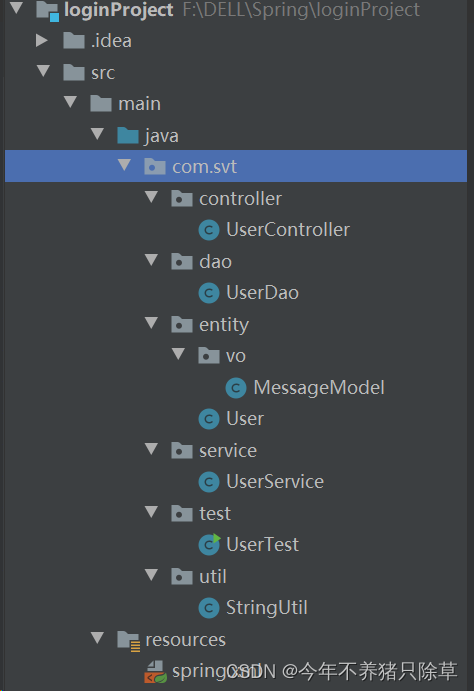注解
- @Resource注解实现自动注入 (反射)
- 代码块
- xml配置文件
- @Autowired注解实现自动化注入
- 代码块
- xml配置文件
- 扫描器-四个注解
- Dao层-@Repository
- Service层-@Service
- Controller层-@Controller
- 测试
- 任意类-@Component
- 常用注解示例-模拟用户登录
- 配置自动扫描的xml文件
- 实体类User
- dao层
- 消息模型对象MessageModel
- service层
- controller层
- 测试Test
- 第一种:用户密码不正确!
- 第二种:用户名或密码不能为空
- 第三种:用户名不存在!
- 第四种:登陆成功!
@Resource注解实现自动注入 (反射)
- 注解默认通过属性字段名称查找对应的bean对象(属性宇段名称与bean标签的id属性值一致)
- 如果属性字段名称不一样,则会通过类型 (CLass ) 类型
- 属性字段可以提供set方法 也可以不提供
- 注解可以声明在属性字段上 或 set 方法级别
- 可以设置注解的name属性,name属性值要与bean标签的id属性值一致(如果设置了name属性,则会按照name 属性查询bean对象)
- 当注入接口时,如果接口只有一个实现类,则正常实例化;如果接口有多个实现类,则需要使用name 属性指定需要被实例化的bean对象
代码块
//注入JavaBean对象@Resourceprivate UserDao userDao;public void test(){System.out.println("UserService Test...");userDao.test();}
public static void main( String[] args ){ApplicationContext ac=new ClassPathXmlApplicationContext("spring.xml");UserService userService= (UserService) ac.getBean("userService");userService.test();}
xml配置文件
<beans xmlns="http://www.springframework.org/schema/beans"xmlns:xsi="http://www.w3.org/2001/XMLSchema-instance"xmlns:context="http://www.springframework.org/schema/context"xsi:schemaLocation="http://www.springframework.org/schema/beanshttps://www.springframework.org/schema/beans/spring-beans.xsdhttp://www.springframework.org/schema/contexthttp://www.springframework.org/schema/context/spring-context.xsd"><!-- 开启自动化注入(装配) --><context:annotation-config></context:annotation-config><!-- 配置bean对象--><bean id="userDao" class="com.svt.dao.UserDao"></bean><bean id="userService" class="com.svt.service.UserService"></bean>
</beans>
@Autowired注解实现自动化注入
- 注解默认使用类型 (CLass 类型) 查找bean 对象,与属性字名称没有关系
- 属性字可以提供set 方法 也可以不提供
- 注解可以声明在属性级别 或 set 方法级别
- 如果想要通过指定名称查bean对象,需要结合@Qualifier 使用(通过设置value 属性值查找,value 属性值要bean标签的id属性值保持一致)
代码块
@Autowiredprivate AccountDao accountDao;public void test(){System.out.println("UserDao Test...");accountDao.test();}
public static void main( String[] args ){ApplicationContext ac=new ClassPathXmlApplicationContext("spring.xml");AccountService accountService= (AccountService) ac.getBean("accountService");accountService.test();}
xml配置文件
<beans xmlns="http://www.springframework.org/schema/beans"xmlns:xsi="http://www.w3.org/2001/XMLSchema-instance"xmlns:context="http://www.springframework.org/schema/context"xsi:schemaLocation="http://www.springframework.org/schema/beanshttps://www.springframework.org/schema/beans/spring-beans.xsdhttp://www.springframework.org/schema/contexthttp://www.springframework.org/schema/context/spring-context.xsd"><!-- 开启自动化注入(装配) --><context:annotation-config></context:annotation-config><!-- account--><bean id="accountDao" class="com.svt.dao.AccountDao"></bean><bean id="accountService" class="com.svt.service.AccountService"></bean>
</beans>
推荐使用@Resource注解是属于J2EE的,减少了与Spring的耦合
原因 来源
来源不同:@Autowired 来自 Spring 框架,而 @Resource 来自于(Java)JSR-250;
@Autowired功能虽说非常强大,但是也有些不足之处。比如它跟Spring强耦合了,如果换成了其他框架,功能就会失效。而@Resource是JSR-250提供的,它是Java标准,绝大部分框架都支持。
依赖查找的顺序不同:@Autowired 先根据类型再根据名称查询,而 @Resource 先根据名称再根据类型查询;
Autowired默认按byType自动装配,而@Resource默认byName自动装配。
支持的参数不同:@Autowired 只支持设置 1 个参数,而 @Resource 支持设置 7 个参数;
@Autowired只包含一个参数:required,表示是否开启自动准入,默认是true。而@Resource包含七个参数,其中最重要的两个参数是:name 和 type。
依赖注入的用法支持不同:@Autowired 既支持构造方法注入,又支持属性注入和 Setter 注入,而 @Resource 只支持属性注入和 Setter 注入;
@Autowired能够用在:构造器、方法、参数、成员变量和注解上,而@Resource能用在:类、成员变量和方法上。
编译器 IDEA 的提示不同:当注入 Mapper 对象时,使用 @Autowired 注解编译器会提示错误,而使用 @Resource 注解则不会提示错误。
@Autowired如果要使用byName,需要使用@Qualifier一起配合。而@Resource如果指定了name,则用byName自动装配,如果指定了type,则用byType自动装配。
扫描器-四个注解
设置了扫描器就只需要在xml文件内自动设置扫描范围,其余交给注解去实例化即可
<beans xmlns="http://www.springframework.org/schema/beans"xmlns:xsi="http://www.w3.org/2001/XMLSchema-instance"xmlns:context="http://www.springframework.org/schema/context"xsi:schemaLocation="http://www.springframework.org/schema/beanshttps://www.springframework.org/schema/beans/spring-beans.xsdhttp://www.springframework.org/schema/contexthttp://www.springframework.org/schema/context/spring-context.xsd"><!--Spring IOC扫描器作用:bean对象的统一管理,简化开发配置,提高开发效率。1.设置自动化扫描的范围如果bean对象未在扫描范围,即使声明了注解,也不会被实例化2.在需要被实例化的JavaBean的类上添加指定的注解(注解声明在类级别) (bean对象的id属性默认是 类的首字母小写)Dao层:@RepositoryService层:@ServiceController层:@Controller任意类:@Component注:开发过程中建议按照规则声明注解。-->
<!-- 设置自动化扫描范围--><context:component-scan base-package="com.svt"></context:component-scan>
</beans>
Dao层-@Repository
@Repository
public class TypeDao {public void test(){System.out.println("TypeDao Test...");}
}Service层-@Service
@Service
public class TypeService {@Resourceprivate TypeDao typeDao;public void test(){System.out.println("TypeService Test...");typeDao.test();}
}
Controller层-@Controller
@Controller
public class TypeController {@Autowiredprivate TypeService typeService;public void test(){System.out.println("TypeController Test...");typeService.test();}
}
测试
public static void main( String[] args ){ApplicationContext ac=new ClassPathXmlApplicationContext("spring02.xml");// TypeDao typeDao= (TypeDao) ac.getBean("typeDao");
// typeDao.test();// TypeService typeService= (TypeService) ac.getBean("typeService");
// typeService.test();TypeController typeController= (TypeController) ac.getBean("typeController");typeController.test();}

任意类-@Component
不在三层架构内,另开了一个类,但是又需要实例化这个类,就可以用@Component注解
注:这个类需要包含在扫描器范围内,否则扫描不到也不会被实例化,最终报错
@Component
public class ProTest {public void test(){System.out.println("ProTest Test...");}
}
public static void main( String[] args ){ApplicationContext ac=new ClassPathXmlApplicationContext("spring02.xml");// TypeDao typeDao= (TypeDao) ac.getBean("typeDao");
// typeDao.test();// TypeService typeService= (TypeService) ac.getBean("typeService");
// typeService.test();TypeController typeController= (TypeController) ac.getBean("typeController");typeController.test();ProTest proTest= (ProTest) ac.getBean("proTest");proTest.test();}

常用注解示例-模拟用户登录

配置自动扫描的xml文件
自定义扫描范围
<beans xmlns="http://www.springframework.org/schema/beans"xmlns:xsi="http://www.w3.org/2001/XMLSchema-instance"xmlns:context="http://www.springframework.org/schema/context"xsi:schemaLocation="http://www.springframework.org/schema/beanshttps://www.springframework.org/schema/beans/spring-beans.xsdhttp://www.springframework.org/schema/contexthttp://www.springframework.org/schema/context/spring-context.xsd"><!-- 设置自动化扫描范围--><context:component-scan base-package="com.svt"></context:component-scan>
</beans>
实体类User
先写一个实体类,放用户名称和用户密码
package com.svt.entity;/*** User实体类*/
public class User {private String userName;//用户名称private String userPwd;//用户密码public String getUserName() {return userName;}public void setUserName(String userName) {this.userName = userName;}public String getUserPwd() {return userPwd;}public void setUserPwd(String userPwd) {this.userPwd = userPwd;}
}
dao层
有了实体类就可以在dao层开始编写代码,先定义登陆的账号密码,再通过用户名查询用户对象,如果存在,返回对应的用户对象,如果不存在,返回null
这里用了注解@Repository
package com.svt.dao;import com.svt.entity.User;
import org.springframework.stereotype.Repository;@Repository
public class UserDao {//定义登陆的账号密码private final String USERNAME="admin";private final String USERPWD="admin";/*** 通过用户名查询用户对象* 如果存在,返回对应的用户对象,如果不存在,返回null* @param userName* @return*/public User queryUserByUserName(String userName){User user=null;//判断用户名是否存在if (!USERNAME.equals(userName)){return null;}//存在user=new User();user.setUserName(USERNAME);user.setUserPwd(USERPWD);return user;}
}
消息模型对象MessageModel
return的user需要接受处理,写一个消息模型对象来处理
package com.svt.entity.vo;/*** 消息模型对象* 用来接收处理结果* resultCode 状态码* 1=成功 0=失败* resultMsg 提示信息*/
public class MessageModel {private Integer resultCode = 1;//状态码private String resulyMag;//提示信息public Integer getResultCode() {return resultCode;}public void setResultCode(Integer resultCode) {this.resultCode = resultCode;}public String getResulyMag() {return resulyMag;}public void setResulyMag(String resulyMag) {this.resulyMag = resulyMag;}
}service层
service层注入dao层的userDao,验证登陆是否成功
这里用了注解@Service,@Resource
package com.svt.service;import com.svt.dao.UserDao;
import com.svt.entity.User;
import com.svt.entity.vo.MessageModel;
import com.svt.util.StringUtil;
import org.springframework.stereotype.Service;import javax.annotation.Resource;@Service
public class UserService {@Resourceprivate UserDao userDao;/*** 验证登陆是否成功* 1. 参数的非空校验* 2. 通过用户名查询用户对象(调用Dao 层的查询方法)* 3.判断密码是否正确* @param uname* @param upwd* @return*/public MessageModel checkUserLogin(String uname,String upwd){//返回消息模型MessageModel messageModel = new MessageModel();//1. 参数的非空校验if (StringUtil.isEmpty(uname) || StringUtil.isEmpty(upwd)){//用户名或密码不能为空messageModel.setResultCode(0);messageModel.setResulyMag("用户名或密码不能为空");return messageModel;}//2. 通过用户名查询用户对象(调用Dao 层的查询方法)User user = userDao.queryUserByUserName(uname);//判断用户对象是否为空if (user==null){messageModel.setResultCode(0);messageModel.setResulyMag("用户名不存在!");return messageModel;}//3.判断密码是否正确if (!upwd.equals(user.getUserPwd())){messageModel.setResultCode(0);messageModel.setResulyMag("用户密码不正确!");return messageModel;}//登陆成功messageModel.setResulyMag("登陆成功!");return messageModel;}
}
其中非空校验用了一个工具类StringUtil
package com.svt.util;/*** 字符串工具类*/
public class StringUtil {/*** 判断字符串是否为空* 为空返回true* 不为空返回false* @param str* @return*/public static boolean isEmpty(String str){if (str==null || "".equals(str.trim())){return true;}return false;}
}
controller层
判断好了用UserController来接收这个对象
这里用了注解@Controller,@Autowired
package com.svt.controller;import com.svt.entity.vo.MessageModel;
import com.svt.service.UserService;
import org.springframework.beans.factory.annotation.Autowired;
import org.springframework.stereotype.Controller;@Controller
public class UserController {@Autowiredprivate UserService userService;public MessageModel userLogin(String uname,String upwd){MessageModel messageModel=userService.checkUserLogin(uname,upwd);return messageModel;}
}
测试Test
一切准备就绪就在UserTest内进行测试
package com.svt.test;import com.svt.controller.UserController;
import com.svt.entity.vo.MessageModel;
import org.springframework.beans.factory.BeanFactory;
import org.springframework.context.support.ClassPathXmlApplicationContext;public class UserTest {public static void main(String[] args) {//获取spring的上下文环境BeanFactory factory=new ClassPathXmlApplicationContext("spring.xml");//得到实例化的userControllerUserController userController= (UserController) factory.getBean("userController");MessageModel messageModel=userController.userLogin("admin","admin");System.out.println("状态码:"+messageModel.getResultCode()+",提示信息:"+messageModel.getResulyMag());}
}不同的用户登录会呈现不同的提示信息
第一种:用户密码不正确!
MessageModel messageModel=userController.userLogin("admin","111");

第二种:用户名或密码不能为空
MessageModel messageModel=userController.userLogin("","");

第三种:用户名不存在!
MessageModel messageModel=userController.userLogin("11","11");

第四种:登陆成功!
MessageModel messageModel=userController.userLogin("admin","admin");








)




)






